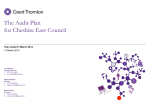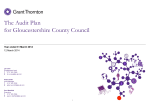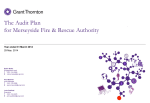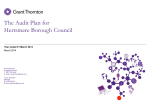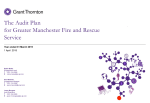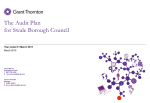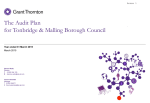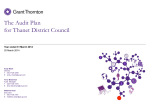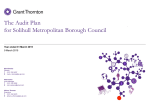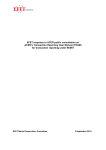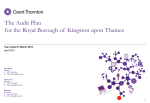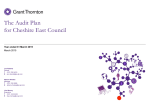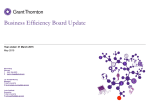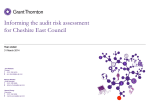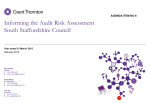Download The Audit Plan – template user guide
Transcript
The Audit Plan for Cheshire Fire Authority Year ended 31 March 2013 April 2013 Julian Farmer Engagement Lead T 01612346385 E [email protected] Alan Rawling Manager T 01612146374 E [email protected] © 2013 Grant Thornton UK LLP | This version of the report is a draft. Its contents and subject matter remain under review and its contents may change and be expanded as part of the finalisation of the report. The contents of this report relate only to the matters which have come to our attention, which we believe need to be reported to you as part of our audit process. It is not a comprehensive record of all the relevant matters, which may be subject to change, and in particular we cannot be held responsible to you for reporting all of the risks which may affect the Authority or any weaknesses in your internal controls. This report has been prepared solely for your benefit and should not be quoted in whole or in part without our prior written consent. We do not accept any responsibility for any loss occasioned to any third party acting, or refraining from acting on the basis of the content of this report, as this report was not prepared for, nor intended for, any other purpose. Contents Section Understanding your business Developments relevant to your business and the audit Our audit approach An audit focused on risks Significant risks identified Other risks Results of interim work Value for Money Logistics and our team Fees and independence Communication of audit matters with those charged with governance Appendices Emerging issues and developments © 2013 Grant Thornton UK LLP | Understanding your business In planning our audit we need to understand the challenges and opportunities the Authority is facing. We set out a summary of our understanding below. Challenges/opportunities 1. Financial resilience 2. Changes to emergency response The Authority's ambition is to continue to deliver high quality services whilst responding to major cuts in public spending • A major review of front line emergency response processes was completed in 2012/13. Wide ranging and fundamental changes to response arrangements are planned to be made over the next few years, including building new fire stations 3. Maintaining value for money from support services A programme of value for money reviews began in 2011/12 to ensure that services are working efficiently and effectively. The reviews are identifying cost reductions and other improvements 4. Fire control The North West Fire Control Centre is due to be fully operational by Spring 2014. The Authority is influential in delivering the new collaborative arrangement which is intended to provide a more effective, efficient and resilient system Our response As part of our VfM conclusion work, we will consider the Authority's financial resilience © 2013 Grant Thornton UK LLP | As part of our VfM conclusion work, we will consider the progress that the Authority is making in implementing the planned changes As part of our VfM conclusion work, we will consider the outcomes from the reviews As part of our VfM conclusion work, we will assess the progress being made in implementing the new arrangements in our meetings with senior management Developments relevant to your business and the audit In planning our audit we also consider the impact of key developments in the sector and take account of national audit requirements as set out in the Code of Audit Practice and associated guidance. Developments and other requirements 1.Financial reporting and Whole of Government Accounts (WGA) Continuing debate about the treatment of the pension fund top-up grant. Changes to the CIPFA Code of limited significance to Fire authorities 2. Policy developments 3. Corporate governance 4. Pensions New Fire & Rescue national Framework published in July 2012 Annual Governance Statement (AGS) The Government has announced the broad thrust of its response to the Hutton Report and the changes it plans to make to fire-fighters pensions from 2013/14 Explanatory foreword New Statement of assurance to be published annually There are changes in 2013/14 to the Local Government Pension Scheme (LGPS) The Authority is required to submit a Whole of Government accounts pack 5. Financial pressures and efficiency Spending Review means reduction in Fire spending, with the changes backloaded Operational efficiency review of the fire service due to report Spring 2013 Our response We will continue to liaise with you, CIPFA and the Audit Commission on the accounting treatment of the pension fund top-up grant We will test the Authority's compliance with the CIPFA Code of Practice We will comply with any audit submission requirements for your WGA pack © 2013 Grant Thornton UK LLP | We will assess the impact of new policy developments, including the new assurance statement, at our regular meetings with senior management. We will provide a view where appropriate We will review the arrangements the Authority has in place for the production of the AGS We will review the AGS and the explanatory foreword to consider whether they are consistent with our knowledge We will assess how the Authority is planning to deal with the impact of the pension scheme changes through our meetings with senior management We will review the Authority's performance against the 2012/13 budget, including consideration of performance against the savings plan Our VFM conclusion will include an assessment of the Authority's financial resilience We will assess the Authority's response to the Operational efficiency review with senior management once the report is published Our audit approach Ensures compliance with International Standards on Auditing (ISAs) Global audit technology Understanding the environment and the entity Understanding the business Inherent risks Significant risks Understanding management’s focus Other risks Evaluating the year’s results Material balances Develop audit plan to obtain reasonable assurance that the Financial Statements as a whole are free from material misstatement and prepared in all materiala respects with the CIPFA Code of Practice framework using our global methodology and audit software Devise audit strategy (planned control reliance?) Yes Extract your data Test controls Test of detail IDEA Substantive Substantive Analyse data analytical analytical Report output using relevant review review to teams parameters Tests of detail General audit procedures Note: a. An item would be considered material to the financial statements if, through its omission or nondisclosure, the financial statements would no longer show a true and fair view. Financial statements Conclude and report Creates and tailors audit programs © 2013 Grant Thornton UK LLP | No Stores audit evidence Documents processes and controls An audit focused on risks We undertake a risk based audit whereby we focus audit effort on those areas where we have identified a risk of material misstatement in the accounts. The table below shows how our audit approach focuses on the risks we have identified through our planning and review of the national risks affecting the sector. Definitions of the level of risk and associated work are given below: Significant – Significant risks are typically non-routine transactions, areas of material judgement or those areas where there is a high underlying (inherent) risk of misstatement. We will undertake an assessment of controls (if applicable) around the risks and carry out detailed substantive testing. Other – Other risks of material misstatement are typically those transaction cycles and balances where there are high values, large numbers of transactions and risks arising from, for example, system changes and issues identified from previous years audits. We will assess controls and undertake substantive testing, the level of which will be reduced where we can rely on controls. None – Our risk assessment has not identified a risk of misstatement. We will undertake substantive testing of material balances. Where an item in the accounts is not material we do not carry out detailed substantive testing. Account Material (or potentially material) balance? Transaction Cycle Inherent risk Material misstatement risk? Description of Risk Substantive testing? Cost of services operating expenses Yes Operating expenses Medium Other Operating expenses understated Cost of services – employee remuneration Yes Employee remuneration Medium Other Remuneration expenses not correct Cost of services – other revenues (fees & charges) Yes Other revenues Low None (Gains)/ Loss on disposal of non current assets No Property, Plant and Equipment Low None Interest payable and similar charges Yes Borrowings Low None Pension Interest cost Yes Employee remuneration Low None Interest & investment income No Investments Low None Return on Pension assets Yes Employee remuneration Low None © 2013 Grant Thornton UK LLP | An audit focused on risks (continued) Account Material (or potentially material) balance? Transaction Cycle Inherent risk Material misstatement risk? Impairment of investments No Investments Low None Income from council tax Yes Revenue Low None Other Government grants Yes Grant Income Low None Capital grants & Contributions (including those received in advance) Yes Property, Plant & Equipment Low None (Surplus)/ Deficit on revaluation of non current assets Yes Property, Plant & Equipment Low None Actuarial (gains)/ Losses on pension fund assets & liabilities Yes Employee remuneration Low None Other comprehensive (gains)/ Losses No Revenue/ Operating expenses Low None © 2013 Grant Thornton UK LLP | Description of Risk Substantive testing? An audit focused on risks (continued) Account Material (or potentially material) balance? Transaction Cycle Inherent risk Material misstatement risk? Property, Plant & Equipment Yes Property, Plant & Equipment Low None Property, Plant & Equipment Yes Property, Plant & Equipment Low None Intangible assets No Intangible assets Low None Investments (long & short term) Yes Investments Low None Debtors (long & short term) Yes Revenue Low None Assets held for sale No Property, Plant & Equipment Low None Inventories No Inventories Low None Cash & cash Equivalents Yes Bank & Cash Low None Borrowing (long & short term) Yes Debt Low None Creditors (long & Short term) Yes Operating Expenses Medium Other Provisions (long & short term) Yes Provision Low None Pension liability Yes Employee remuneration Low None Reserves Yes Equity Low None Income to the firefighters' pension fund Yes Firefighters' pensions Low None © 2013 Grant Thornton UK LLP | Description of Risk Creditors understated or not recorded in the correct period Substantive testing? An audit focused on risks (continued) Account Material (or potentially material) balance? Transaction Cycle Inherent risk Material misstatement risk? Description of Risk Substantive testing? Spending by the Fund Yes Firefighters' pension Medium Other Payments to pensioners incorrectly calculated Top up grant receivable Yes Grant income Low None Net current assets and liabilities Yes Firefighters' pension Low None © 2013 Grant Thornton UK LLP | Significant risks identified 'Significant risks often relate to significant non-routine transactions and judgmental matters. Non-routine transactions are transactions that are unusual, either due to size or nature, and that therefore occur infrequently. Judgmental matters may include the development of accounting estimates for which there is significant measurement uncertainty' (ISA 315). In this section we outline the significant risks of material misstatement which we have identified. There are two presumed significant risks which are applicable to all audits under auditing standards (International Standards on Auditing – ISAs) which are listed below: Significant risk Description Substantive audit procedures The revenue cycle includes fraudulent transactions Under ISA 240 there is a presumed risk that revenue may be misstated due to the improper recognition of revenue. Work completed to date: Discussed with management and assessed the controls in place to prevent and detect fraudulent transactions Completion of entity level control evaluation Further work planned: Management over-ride of controls © 2013 Grant Thornton UK LLP | Under ISA 240 there is a presumed risk that the risk of management over-ride of controls is present in all entities. Review and testing of revenue recognition policies Testing on material revenue streams Work completed to date: Discussion with management and evaluation of responses. Further work planned: Review of accounting estimates, judgments and decisions made by management Testing of journal entries Review of unusual significant transactions Other risks The auditor should evaluate the design and determine the implementation of the entity's controls, including relevant control activities, over those risks for which, in the auditor's judgment, it is not possible or practicable to reduce the risks of material misstatement at the assertion level to an acceptably low level with audit evidence obtained only from substantive procedures (ISA 315). Other reasonably possible risks Description Work completed to date Further work planned Operating expenses Operating expenses understated Documentation of processes and controls Evaluation and walkthrough of controls Selection of a sample of expenditure items for substantive testing Operating expenses Creditors understated or not recorded in the correct period Documentation of processes and controls Evaluation and walkthrough of controls Selection of a sample of expenditure items for substantive testing Detailed review and testing of year end accruals and creditor balances Employee remuneration Remuneration expenses not correct Documentation of processes and controls Possible testing of key controls Evaluation and walkthrough of controls Selection of a sample of expenditure items for substantive testing Firefighters' pensions Payments to pensioners incorrectly calculated Documentation of processes and controls Substantive testing of payments made to pensioners Evaluation and walkthrough of controls © 2013 Grant Thornton UK LLP | Results of interim audit work Scope As part of the interim audit work and in advance of our final accounts audit fieldwork, we have considered: • the effectiveness of the internal audit function • internal audit's work on the Authority's key financial systems • walkthrough testing to confirm whether controls are implemented as per our understanding in areas where we have identified a risk of material misstatement • a review of Information Technology (IT) controls Work performed Conclusion/ Summary Internal audit We have reviewed internal audit's overall arrangements. Where the arrangements are deemed to be adequate, we can gain assurance from the overall work undertaken by internal audit and can conclude that the service itself is contributing positively to the internal control environment and overall governance arrangements within the Authority. Overall, we have concluded that the Internal Audit service continues to provide an independent and satisfactory service to the Authority and that we can take assurance from their work in contributing to an effective internal control environment at the Authority. Walkthrough testing Walkthrough tests have been completed in relation to the specific accounts assertion risks which we consider to present a risk of material misstatement to the financial statements. In-year internal controls were observed to be operating in accordance with our documented understanding. We reported two issues to the Head of Finance: • that the reconciliation of the general ledger to the payroll reports provided by the service provider is no longer being performed. The Head of Finance will ensure that the reconciliations are completed as part of the year end process; and • that the Head of Finance is able to raise journal entries. The Head of Finance considers that this is necessary for business continuity because of the small size of the finance team. He states that he has not raised any journal entries in 2012/13. We have not yet completed our evaluation of how the Authority assures itself that appropriate controls are in place at its payroll and pensions service provider to ensure that calculations are being made correctly. We will provide an update on this issue in our Annual Governance Report. © 2013 Grant Thornton UK LLP | Results of interim audit work (continued) Review of information technology (IT) controls © 2013 Grant Thornton UK LLP | Work performed Conclusion/ Summary Our information systems specialist will perform a high level review of the general IT control environment, as part of the overall review of the internal controls system. This will include a follow up of the issues raised in the previous year. Any issues arising from the high level review will be brought to the attention of officers and the Authority, if required. Value for Money Introduction The Code of Audit Practice requires us to issue a conclusion on whether the Authority has put in place proper arrangements for securing economy, efficiency and effectiveness in its use of resources. This is known as the Value for Money (VfM) conclusion. 2012/13 VFM conclusion Our Value for Money conclusion will be based on two reporting criteria specified by the Audit Commission. We will tailor our VfM work to ensure that as well as addressing high risk areas it is, wherever possible, focused on the Authority's priority areas and can be used as a source of assurance members. Where we plan to undertake specific reviews to support our VfM conclusion, we will issue a Terms of Reference for each review outlining the scope, methodology and timing of the review. These will be agreed in advance and presented to the Authority or appropriate Committee. The results of all our local VfM audit work and key messages will be reported in our Audit Findings report and in the Annual Audit Letter. We will agree any additional reporting to the Authority on a review-by-review basis. © 2013 Grant Thornton UK LLP | Code criteria The Authority has proper arrangements in place for: • securing financial resilience • challenging how it secures economy, efficiency and effectiveness in its use of resources We will consider whether the Authority is prioritising its resources with tighter budget Work to be undertaken Risk-based work focusing on arrangements relating to financial governance, strategic financial planning and financial control. Specifically we will: • review the 2011/12 VfM conclusion • review the 2012/13 Annual Governance Statement • review the 2013/14 Integrated Risk Management Plan and key financial reports • review of reports by other regulators and external bodies • discuss the Authority's VfM arrangements with officers • review any relevant work or reports of Internal Audit • do specific work in response to any risks identified during the audit Logistics and our team The audit cycle March 2013 Interim audit visit July 2013 Final accounts visit August 2013 Completion/ reporting Key phases of our audit 2012-2013 Our team Julian Farmer Engagement Lead T 0161 M0 E [email protected] Paul Morgan Associate T 01612146380 E [email protected] © 2013 Grant Thornton UK LLP | Alan Rawling Manager T 01612146374 M 07880456168 E [email protected] Date Activity January/ February 2013 Planning meetings March 2013 Interim site work 17 April 2013 The audit plan presented to the Authority September 2013 Debrief 1 July 2013 Year end fieldwork commences 31 August 2013 Audit findings clearance meeting September 2013 Authority meeting to report our findings By 30 September 2013 Sign financial statements and VfM conclusion By 31 October 2013 Issue Annual Audit Letter Fees and independence Fees Fees for other services £ Authority audit 39,813 Total 39,813 Service Fees £ None Nil Our fee assumptions include: Independence and ethics Our fees are exclusive of VAT Supporting schedules to all figures in the accounts are supplied by the agreed dates and in accordance with the agreed upon information request list We confirm that there are no significant facts or matters that impact on our independence as auditors that we are required or wish to draw to your attention. We have complied with the Auditing Practices Board's Ethical Standards and therefore we confirm that we are independent and are able to express an objective opinion on the financial statements. The scope of the audit, and the Authority and its activities have not changed significantly Full details of all fees charged for audit and non-audit services will be included in our Audit Findings report at the conclusion of the audit. The Authority will make available management and accounting staff to help us locate information and to provide explanations We confirm that we have implemented policies and procedures to meet the requirement of the Auditing Practices Board's Ethical Standards. © 2013 Grant Thornton UK LLP | Communication of audit matters with those charged with governance International Standards on Auditing (ISA) 260, as well as other ISAs, prescribe matters which we are required to communicate with those charged with governance, and which we set out in the table opposite. This document, The Audit Plan, outlines our audit strategy and plan to deliver the audit, whilst The Audit Findings will be issued prior to approval of the financial statements and will present key issues and other matters arising from the audit, together with an explanation as to how these have been resolved. Our communication plan Audit Audit plan findings Respective responsibilities of auditor and management/those charged with governance Overview of the planned scope and timing of the audit. Form, timing and expected general content of communications We will communicate any adverse or unexpected findings affecting the audit on a timely basis, either informally or via a report to the Authority. Views about the qualitative aspects of the entity's accounting and financial reporting practices, significant matters and issue arising during the audit and written representations that have been sought Appendix A provides the Authority with a summary of emerging national issues and developments that may be relevant to you as an Authority. The summary includes a number of challenge questions in respect of these emerging issues which you may wish to consider. Confirmation of independence and objectivity A statement that we have complied with relevant ethical requirements regarding independence, relationships and other matters which might be thought to bear on independence. Members can find further useful material on our website www.grant-thornton.co.uk, where we have a section dedicated to our work in the public sector. Here you can download copies of our publications. Respective responsibilities This plan has been prepared in the context of the Statement of Responsibilities of Auditors and Audited Bodies issued by the Audit Commission (www.auditcommission.gov.uk). We have been appointed as the Authority's independent external auditors by the Audit Commission, the body responsible for appointing external auditors to local public bodies in England. As external auditors, we have a broad remit covering finance and governance matters. Our annual work programme is set in accordance with the Code of Audit Practice ('the Code') issued by the Audit Commission and includes nationally prescribed and locally determined work. Our work considers the Authority's key risks when reaching our conclusions under the Code. It is the responsibility of the Authority to ensure that proper arrangements are in place for the conduct of its business, and that public money is safeguarded and properly accounted for. We have considered how the Authority is fulfilling these responsibilities. © 2013 Grant Thornton UK LLP | Details of non-audit work performed by Grant Thornton UK LLP and network firms, together with fees charged. Details of safeguards applied to threats to independence Material weaknesses in internal control identified during the audit Identification or suspicion of fraud involving management and/or others which results in material misstatement of the financial statements Non compliance with laws and regulations Expected modifications to the auditor's report, or emphasis of matter Uncorrected misstatements Significant matters arising in connection with related parties Significant matters in relation to going concern Appendices © 2013 Grant Thornton UK LLP | Emerging issues and developments Accounting and audit issues Provisions Under IAS 37 'Provisions, Contingent Liabilities and Contingent Assets', the criteria for recognising a provision is that there is: • a current obligation as a result of a past event; • a transfer of economic benefit is probable; and • a reliable estimate of the liability can be made. We wish to highlight the following matters to you for consideration where a provision may be required: • Mutual Municipal Insurance – the Scheme of Arrangement was triggered in November 2012, therefore it is now virtually certain that there will be a transfer of economic benefit. If this liability has not been discharged by 31 March 2013, we would expect local authorities to recognise a creditor or, if the timing or amount of the payment is uncertain, a provision in their financial statements. • Equal pay - in October 2012 the supreme court ruled that more than 170 former Birmingham City Council employees can make equal pay claims. This effectively extends the time workers have to bring equal pay compensation claims from six months to six years. We would expect local authorities to consider whether they have received any additional claims and, where the criteria set out in IAS 37 have been met, recognise a provision. • Redundancy costs –the recognition point for termination benefits fall under IAS 19 'Employee Benefits'. This is generally earlier than the IAS 37 recognition criteria for restructuring which requires that a valid expectation has been raised in those affected. The requirement in IAS 19 is that the entity is 'demonstrably committed'. Questions for members to consider: • Has your Head of Finance considered the need for additional provisions for the above matters? © 2013 Grant Thornton UK LLP | Emerging issues and developments Grant Thornton reports 'Towards a tipping point?: Summary findings from our second year of financial health checks of English local authorities ' In December 2012, Grant Thornton published 'Towards a tipping point?: Summary findings from our second year of financial health checks of English local authorities'. Although this report was produced on the basis of information from local authorities, the messages in this report are still relevant to you. This financial health review considers key indicators of financial performance, financial governance, strategic financial planning and financial controls to provide a summary update on how the sector is coping with the service and financial challenges faced. The report provides a summary of the key issues, trends and good practice emerging from the review. Questions for members to consider: • Have you considered the findings of the report? • Are there any issues that relate to your authority and what action are you going to take? © 2013 Grant Thornton UK LLP | Emerging issues and developments Local government guidance 'Tough Times: Councils' financial health in challenging times' In November, the Audit Commission published 'Tough times 2012: Councils' financial health in challenging times.' This is the second report it has produced looking at how councils are dealing with the issues from the Spending Review and focuses on the financial health of councils. Although this report was produced on the basis of information from local authorities, the messages in this report are still relevant to you. The report finds that councils generally delivered on their planned savings, however, auditors reported that signs of financial stress were visible. T Questions for members to consider: • Have you considered the findings of the report and any actions required? 'Protecting the public purse 2012' In November, the Audit Commission published 'Protecting the public purse 2012: Fighting fraud against local government'. The report provides the results of the Audit Commission's annual survey of English local government bodies. Although this report was produced on the basis of information from local authorities, the messages in this report are still relevant to you It finds that local government bodies are targeting their investigative resources more efficiently and effectively. Local government bodies detected more than 124,000 cases of fraud in 2011/12 totalling £179m. It also reports that new frauds are emerging in areas such as business rates, Right to Buy housing discounts and schools. The report includes a checklist for those charged with governance to use to review their counter-fraud arrangements. Questions for members to consider: • Have you considered the findings of the report? • Are there any issues that could relate to your authority and how are these being dealt with? • Have you reviewed your existing arrangements for tackling fraud? If you have any fraud queries, talk to your audit manager to see how Grant Thornton could help. © 2013 Grant Thornton UK LLP | Emerging issues and developments Local government guidance Operational efficiencies review During January to March 2013, there is to be a review into the operational efficiency of the services delivered by fire and rescue authorities in England by Sir Ken Knight, the outgoing Chief Fire and Rescue Adviser. A final report is to be presented to Ministers in Spring 2013. The review will look at options for savings both within and beyond the current Spending Review period including through: • Firefighter training • Flexible staffing and crewing arrangements • The use of retained firefighters • Procurement • Shared services • Collaboration with emergency services and other organisations on service delivery and estates • Sickness management • Sharing of senior staff • Locally led mergers and operational collaborations • New Fire-fighting technology • Preventative approaches • Working with local businesses Fire and rescue authorities have been invited to put forward their views. Challenge questions: • Are your officers going to contribute to the operational efficiencies review? © 2013 Grant Thornton UK LLP | © 2013 Grant Thornton UK LLP. All rights reserved. 'Grant Thornton' means Grant Thornton UK LLP, a limited liability partnership. Grant Thornton is a member firm of Grant Thornton International Ltd (Grant Thornton International). References to 'Grant Thornton' are to the brand under which the Grant Thornton member firms operate and refer to one or more member firms, as the context requires. Grant Thornton International and the member firms are not a worldwide partnership. Services are delivered independently by member firms, which are not responsible for the services or activities of one another. Grant Thornton International does not provide services to clients. grant-thornton.co.uk
























